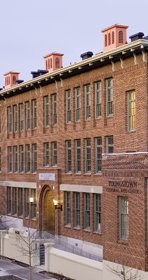Did this occur in Youngstown, Ohio?

Well, not quite. It took place in the Delridge neighborhood in the city of Seattle. It turns out that this neighborhood on the western side of Puget Sound was at one point named Youngstown before it was incorporated into the city. Why was it named this? It seems two gentlemen, William Pigott and Judge Wilson from our little ol' Youngstown in Ohio established a steel mill in the area named Seattle Steel back in 1904 and renamed the area "Youngstown". The Youngstown School was built in 1907 as a place to educate the children of the immigrants who worked there. The school continued to function until 1989, when it was judged as seismically unsafe and closed. In 1999 the Delridge Neighborhoods Development Association made refurbishing the boarded-up school a priority in their neighborhood's master plan.
People from various income levels can afford to live in the building, as stated in a recent story in the Seattle Times :
The four-story building is home to an alternative school, a handful of arts organizations and even artists themselves. A hard rocker from New Jersey and a couple of trapeze artists from Seattle are among those who dwell in the 36 low-income studios atop the first-floor public space. Artists must earn less than half of the Seattle-area median income — for a single person, that's $27,250 a year — to qualify, said Philippa Nye, former project manager of the Youngstown Cultural Arts Center.
And already I can hear the whiners sitting at their computers in Ohio reading this and saying "but that was in Seattle" and "projects like that require money" which are worthwhile statements, but sometimes you need to look outside your backyard to see the projects that can take shape within your backyard. This story is a fantastic example of how people came together to support their local arts community - an arts community that now uses refurbished historical architecture and contributes to the tax base of the city.
Within the last year, fire destroyed the Mattress Factory Arts Center, a place in Youngstown where the existing creative community both lived and worked. And now the community is scattered. Conversations with the Youngstown CIC to renovate the Semple Building into artist lofts have been openly discussed and proposed, but so far no action has been taken.
The Salvation Army Building on Mahoning Avenue could also have been a potential location for many types of redevelopment including artist lofts, but within a very short amount of time the building went from a propery of value to an blighted eyesore to be demolished . . . due to poor ownership, failure to secure and police the building, and excessive vandalization. Two ongoing online debates on the issue can be found here and here.
I believe this story teaches us three things:
1 - interesting projects incorporating the arts and housing are possible, and we need to be open to opportunties such as these because a thriving arts community adds to the economic development of an area.
2 - we need to take the steps as a community to secure and protect our historical structures now, instead of waiting until they are blighted, eventually leaving us with few options.
3 - strong neighborhood organizations and bountiful community input may create innovative solutions to problems.
Incidentally, the steel mill started over 100 years ago by those guys from Youngtown, Ohio is still functioning today in the city of Seattle, after a series of modernizations over the decades.




No comments:
Post a Comment